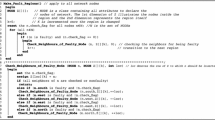Abstract
Irregular topologies have become more attractive choice than their regular counterparts for network-on-chip (NoC) designs since they have lower power consumptions, higher throughputs, and lower latencies. These topologies use the minimum required network resources to minimize some design objectives such as energy and performance. Hence, they are designed to guarantee only one way between application nodes. Therefore, a single permanent link failure may cause a complete breakdown for the designed chip. Previous studies presented an irregular topology design method that adds extra routers and links to have alternative paths between nodes. These topologies use the main routing table if there is no failure on the design. It stores the alternative routing options on routing tables, which can be activated by the external pins of the chip when there is a fault on a link. However, the alternative routings increase the energy consumption and latency of the packets. One solution to mitigate the energy and latency increase can be implementing the design as a 3D NoC, which utilizes faster and less energy consuming through silicon vias between different layers. In this study, we present a method that generates irregular fault-tolerant topology and routing for 3D NoCs. We compare the proposed method with its 2D counterpart on three benchmarks from literature based on energy consumption and chip area. The results show that 3D-based method brings significant energy improvements, especially in alternative routings. Additionally, we observed that employing 3D structure reduces the area proportional to the number of 3D layers, which makes the 3D design a perfect choice for the designed fault-tolerant system.









Similar content being viewed by others
References
Dally WJ, Towles B (2001) Route packets, not wires: on-chip interconnection networks. In: Design Automation Conference, 2001. Proceedings. IEEE, pp 684–689
International Technology Roadmap for semiconductors (2015) http://public.itrs.net/
Mark W (2009) A study of nanometer semiconductor scaling effects on microelectronics reliability. PhD Thesis, University of Maryland
Chang Y-C et al (2011) On the design and analysis of fault tolerant NoC architecture using spare routers. In: Proceedings of the 16th Asia and South Pacific Design Automation Conference. IEEE Press
Arabnia HR, Bhandarkar SM (1996) Parallel stereocorrelation on a reconfigurable multi-ring network. J supercomput 10(3):243–269
Touzene A, Day K (2015) All-to-all broadcasting in torus network on chip. J Supercomput 71(7):2585–2596
Ren Y et al (2013) A fault tolerant NoC architecture using quad-spare mesh topology and dynamic reconfiguration. J Syst Architect 59(7):482–491
Safaei F, ValadBeigi M (2012) An efficient routing methodology to tolerate static and dynamic faults in 2-D mesh networks-on-chip. Microprocess Microsyst 36(7):531–542
Srinivasan K, Chatha KS, Konjevod G (2006) Linear-programming-based techniques for synthesis of network-on-chip architectures. IEEE Trans Very Large Scale Integr (VLSI) Syst 14(4):407–420
Dumitriu V, Khan GN (2009) Throughput-oriented NoC topology generation and analysis for high performance SoCs. IEEE Trans Very Large Scale Integr VLSI Syst 17(10):1433–1446
Siewiorek D, Swarz R (2017) Reliable computer systems: design and evaluatuion. Digital Press, Butterworth
Tosun S, Ajabshir VB, Mercanoglu O, Ozturk O (2015) Fault-tolerant topology generation method for application-specific network-on-chips. IEEE Trans Comput-Aided Des Integr Circuit Syst 34(9):1495–1508
Ajabshir VB, Tosun S (2014) Fault-tolerant routing for irregular-topology-based network-on-chips. In: Second International Symposium on Computing and Networking, IEEE, 2014, pp 123–129
Koyanagi M, Nakamura T, Yamada Y, Kikuchi H, Fukushima T, Tanaka T, Kurino H (2006) Three-dimensional integration technology based on wafer bonding with vertical buried interconnections. IEEE Trans Electron Dev 53(11):27992808
Van der Plas G et al (2011) Design issues and considerations for low-cost 3-D TSV IC technology. IEEE J Solid-State Circuits 46(1):293–307
Karypis G, Kumar V (1998) A fast and high quality multilevel scheme for partitioning irregular graphs. SIAM J Sci Comput 20(1):359–392
Kirkpatrick S, Gelatt CD, Vecchi MP (1983) Optimization by simulated annealing. Science 220(4598):671–680
Marcon CAM, Moreno EI, Calazans NLV, Moraes FG (2008) Comparison of network-on-chip mapping algorithms targeting low energy consumption. Comput Dig Tech IET 2(6):471–482
Cormen TH, Leiserson CE, Rivest RL, Stein C (2001) Introduction to algorithms. MIT Press, Cambridge
Kim DH, Mukhopadhyay S, Lim SK (2009) TSV-aware interconnect length and power prediction for 3D stacked ICs. Proceedings of the 2009 IEEE International Interconnect Technology Conference, IITC 2009, pp 26–28
Lee K, Nakamura T, Ono T, Yamada Y, Mizukusa T, Hashimoto H, Park K, Kurino H, Koyanagi M (2000) Three-dimensional shared memory fabricated using wafer stacking technology. In: Electron Devices Meeting, 2000 IEDM’00. Technical Digest. International. IEEE 2000, pp 165–168
Pothen A, Simon HD, Liou K-P (1990) Partitioning sparse matrices with eigenvectors of graphs. SIAM J Matrix Anal Appl 11(3):430–452
Fiduccia CM, Mattheyses RM (1988) A linear-time heuristic for improving network partitions. Papers on twenty-five years of electronic design automation. ACM
Kernighan BW, Lin S (1970) An efficient heuristic procedure for partitioning graphs. Bell Syst Tech J 49(2):291–307
Hu J, Marculescu R (2005) Energy-and performance-aware mapping for regular NoC architectures. IEEE Trans Comput Aided Des Integr Circuits Syst 24(4):551–562
Kim H, Ghoshal P, Grot B, Gratz PV, Jiménez DA (2011) Reducing network-on-chip energy consumption through spatial locality speculation. In: Proceedings of the Fifth ACM/IEEE International Symposium on Networks-on-Chip. ACM, pp 233–240
Acknowledgements
This work was supported by The Scientific and Technological Research Council of Turkey (TÜBITAK) under Grant No. 117E130.
Author information
Authors and Affiliations
Corresponding author
Rights and permissions
About this article
Cite this article
Tosun, S., Ajabshir, V.B. Energy-aware partitioning of fault-tolerant irregular topologies for 3D network-on-chips. J Supercomput 74, 4842–4863 (2018). https://doi.org/10.1007/s11227-018-2491-6
Published:
Issue Date:
DOI: https://doi.org/10.1007/s11227-018-2491-6




